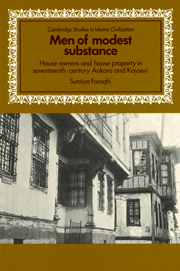Book contents
- Frontmatter
- Contents
- Tables
- Graphs
- Illustrations
- Figures
- Abbreviations
- Preface
- Introduction
- 1 Setting the scene: two cities of central Anatolia
- 2 The physical shape of urban houses
- 3 The cost of buying a house
- 4 Urban property-owners
- 5 The difficulties of an urban property-owner
- Conclusion
- Glossary
- Notes
- Bibliography
- Index
1 - Setting the scene: two cities of central Anatolia
Published online by Cambridge University Press: 18 November 2009
- Frontmatter
- Contents
- Tables
- Graphs
- Illustrations
- Figures
- Abbreviations
- Preface
- Introduction
- 1 Setting the scene: two cities of central Anatolia
- 2 The physical shape of urban houses
- 3 The cost of buying a house
- 4 Urban property-owners
- 5 The difficulties of an urban property-owner
- Conclusion
- Glossary
- Notes
- Bibliography
- Index
Summary
Ankara in the pre-Ottoman period
After 1923, when Ankara had become the capital of the Turkish Republic, a considerable amount of archaeological research was undertaken both in the city itself and in the surrounding region. Thus in spite of the scarcity of written documents, the pre-Ottoman development of the city is reasonably well-known. Ankara is located on the northern edge of the inner Anatolian steppe, in a place where small rivers and lakes provide fairly abundant water resources. As a result, the site has been occupied by settlements of varying size and importance ever since pre-Roman times. Archeological evidence and written sources show that in the third century B.C., Ankara was the centre of the Galatian tribe of the Tectosages, although it is difficult to determine to what degree this settlement possessed urban character.
After incorporation into the Roman Empire, the capital of the Tectosages turned into a good-sized provincial town, of a type frequently to be found in Anatolia. Excavations have shown that Roman Ankara possessed the public buildings to be expected in a settlement of this type, including hot baths and a theatre. From the extent of the built-up area, which encompassed not only the fortified hill, but equally areas in the modern Ulus district only reincorporated into the city during the present century, it has been concluded that Roman Ankara was a city of rather more than average size. Among the public buildings of this period, the best known is the temple of Augustus and Roma, which contains an inscription relating the text of Augustus' testament. The latter has attracted the interest of researchers ever since its first modern transcription in the sixteenth century.
- Type
- Chapter
- Information
- Men of Modest SubstanceHouse Owners and House Property in Seventeenth-Century Ankara and Kayseri, pp. 23 - 64Publisher: Cambridge University PressPrint publication year: 1987

